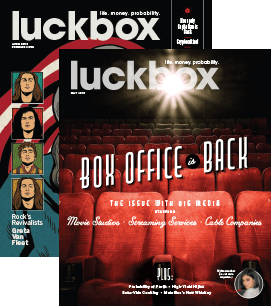Rolls-Royce: From Luxury Cars to Aerospace and Defense
The company has turned around, but its premium valuation suggests it will need to keep growing rapidly for its shares to continue to outperform

- Stock in Rolls-Royce has surged more than 30% in 2025, thanks to its continuing strategic turnaround.
- The company’s Power by the Hour” model, combined with the rebound in air travel and increased defense spending, has boosted its financial performance and inspired confidence among investors.
- But its premium valuation suggests it will need to keep growing rapidly for its shares to continue to outperform.
When most people think of Rolls-Royce (RYCEF), they picture luxury cars cruising the streets in timeless opulence. But the company began making aircraft engines more than a century ago and has by now has progressed far beyond its automotive origins, even going so far as to license BMW to make today’s Roll Royce cars in a U.K. plant.
Today, it’s a global powerhouse in aerospace, defense and power systems, making critical contributions to everything from cutting-edge jet engines to nuclear propulsion. Investors are watching closely as the transformation continues.
So, let’s take a closer look at the company’s financial turnaround and at how the valuation is changing alongside its impressive recovery. With high expectations built into the current price, the question is whether the company can maintain its momentum—and whether investors might be paying too much for its stock because of strong prospects for growth. We’ll dive into the numbers and see where things stand.

From luxury automaker to industrial powerhouse
Rolls-Royce, founded in 1906 in Derby, England, now operates in more than 50 countries. The company began expanding its scope beyond manufacturing cars in 1914 when it started making aircraft engines. It became a major supplier of engines for British and American planes in World War II and helped develop the first jet engines. But its efforts to diversify gained momentum in the 1970s and have become especially intense in the last fifteen years.
The pandemic weighed heavily on the global aerospace industry but also prompted Rolls Royce to expand more quickly in high-growth areas like defense and nuclear energy, while continuing to enlarge its civil aerospace division. One key to the company’s recovery has been “Power by the Hour” model, a flexible engine maintenance system that enables aircraft owners to pay based on usage. It gained traction as air travel rebounded sharply post-pandemic.
Under CEO Tufan Erginbilgic, who took charge in 2023, Rolls-Royce has undergone a strategic overhaul by reducing the workforce and the selling nonessential assets. Those moves paid off with the company’s stock surging over 30% in 2025. It now trades at around $10 per share with a market capitalization of roughly $80 billion—a stark contrast to the stock’s dip below $2/share in 2021, 2022 and early 2023. Investors have clearly taken notice of the company’s positive trajectory.
However, as optimistic as the future appears, Rolls-Royce still faces uncertainty. The company remains susceptible to macroeconomic volatility and geopolitical risk, with potential threats such as rising tariffs and global economic slowdowns. Still, with strong leadership and a diversified portfolio, Rolls-Royce looks well-positioned to maintain its momentum, making it an exciting company to watch as it charts this new path.

A transformative year for the bottom line
As reflected in its latest earnings report, Rolls-Royce is in the midst of an impressive financial turnaround. The company posted a revenue increase of 16% year-over-year, reaching approximately $22.6 billion for 2024, exceeding analysts’ expectations of $21.5 billion. Operating profit also surged by an impressive 57% to about $3.1 billion, while operating margin rose from 10.3% in 2023 to 13.8% in 2024. This strong performance resulted directly from the company’s cost-cutting measures, operational efficiency and a more disciplined approach to its portfolio. Notably, the civil aerospace division led the charge, with a 24% increase in revenue, aided by a boost in engine flying hours and strong aftermarket performance.
The company’s free cash flow rose 88%, reaching approximately $3 billion, up from $1.6 billion in 2023. This robust cash generation enabled it to reduce its net debt to about $590 million, a sharp contrast to the $2.4 billion net debt position at the end of 2023. The firm’s balance sheet is considerably healthier, and it has been recognized by credit agencies with an investment-grade rating and a positive outlook. The improvements in cash flow and debt management underscore the success of the transformation strategy .
Looking ahead, Rolls-Royce has set ambitious targets by upgrading its mid-term financial guidance. The company now expects underlying operating profit to range between $3.4 billion and $3.6 billion in 2025, with free cash flow in the same range. It also plans a $1.3 billion share buyback program for 2025, which enhances confidence among investors. The company’s resilience, even amid continuing supply chain challenges, is a testament to its strategic focus on enhancing profitability and driving growth across its civil aerospace, defense and power systems divisions. This diversified approach is crucial for Rolls-Royce’s ability to weather broader economic uncertainty, including intensifying global trade tension.
Despite the strong performance in 2024, Rolls-Royce does face risks, particularly in its civil aerospace division, which remains sensitive to fluctuations in demand for air travel. Moreover, the upheaval in the geopolitical landscape (e.g. tariffs) could inject additional uncertainty into the global defense sector. Those concerns aside, the company’s recent accomplishments and the achievement of some key financial milestones suggest it remains well-positioned for continued growth. With a healthy balance sheet, improving cash flow and a robust order book, it has the potential to sustain its momentum in 2025 and beyond.

Rising valuation reflects high expectations
Rolls-Royce’s recent turnaround has undoubtedly caught the attention of investors, pushing shares up more than 30% so far in 2025. But as the company’s performance improves, its valuation metrics are also moving higher, raising questions about how much upside remains in the stock. With a P/E ratio sitting at 25.3, compared to the sector median of 21.1, investors are now paying a premium for the company’s earnings. This elevated P/E suggests the company is performing well, but the market may be pricing in future growth at an overly optimistic rate.
Moreover, Rolls-Royce’s price-to-sales (P/S) ratio of 3.3 is notably higher than the sector average of 1.3. This reflects the market’s anticipation of continued strong growth, particularly in civil aerospace and defense. However, such a high multiple can also signal the stock is trading at an inflated value relative to its revenue generation, suggesting the market may be overly optimistic about the company’s near-term prospects.
Of the analysts covering the stock, 14 rate it as a “buy” or “overweight,” while two award it a “sell” or “underweight” rating. The average price target for the stock is around $8, which is below its current trading price of about $9.50 per share. This discrepancy suggests that despite the company’s strong performance, analysts may be cautious about the stock’s ability to its trajectory at these elevated levels.
To justify its share price, Rolls-Royce will need to not only sustain its impressive momentum but also build upon it. The latest earnings report suggests the company is on the right track, but lingering uncertainties—particularly around U.S. tariffs—raise questions about whether this growth can be maintained in the short term. The future of Rolls-Royce’s stock, therefore, will depend heavily on broader economic conditions.
If global trade tensions escalate, it’s reasonable to assume the broader economy could experience a slowdown, which would likely weigh on the prospects of companies like Rolls-Royce. However, geopolitical shifts—particularly the U.S. cutting its support for Ukraine—could result in a boost for the European defense sector, Rolls-Royce included. This dynamic introduces an intriguing opportunity for the company.

Investment takeaways
Rolls-Royce’s turnaround has been nothing short of spectacular, with shares climbing sharply in 2025, driven by strong performance in aerospace, defense and nuclear energy. However, this newfound momentum comes with a price. The stock is now trading at a slight premium, with a P/E ratio above the sector median and a high P/S ratio that reflects investor exuberance. But for this growth story to continue, the company will need to continue its recent success while navigating near-term uncertainty.
That said, there’s an intriguing wild card in the mix. As defense spending in Europe ramps up and Rolls-Royce potentially locks in new contracts—particularly for its submarines—the company may have new opportunities for growth. Under that favorable scenario, shares could see further upside. Longer-term, this stock just feels like it will continue to float higher—in part because of its amazing resilience amid the current market volatility.
Andrew Prochnow, a frequent contributor to Luckbox, has traded the global financial markets for more than 15 years, including 10 years as a professional options trader.
For live daily programming, market news and commentary, visit tastylive or the YouTube channels tastylive (for options traders), and tastyliveTrending for stocks, futures, forex & macro.
Trade with a better broker, open a tastytrade account today. tastylive, Inc. and tastytrade, Inc. are separate but affiliated companies.





















